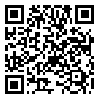Volume 13, Issue 1 (January & February 2022)
BCN 2022, 13(1): 15-24 |
Back to browse issues page
Download citation:
BibTeX | RIS | EndNote | Medlars | ProCite | Reference Manager | RefWorks
Send citation to:



BibTeX | RIS | EndNote | Medlars | ProCite | Reference Manager | RefWorks
Send citation to:
Borjkhani H, Borjkhani M, Sharif M A. Investigating the Cocaine-induced Reduction of Potassium Current on the Generation of Action Potentials Using a Computational Model. BCN 2022; 13 (1) :15-24
URL: http://bcn.iums.ac.ir/article-1-1541-en.html
URL: http://bcn.iums.ac.ir/article-1-1541-en.html
1- School of Engineering Sciences, University of Tehran, Tehran, Iran.
2- Department of Electrical Engineering, School of Industrial Technologies, Urmia University of Technology, Urmia, Iran.
2- Department of Electrical Engineering, School of Industrial Technologies, Urmia University of Technology, Urmia, Iran.
Abstract:
Introduction: Drugs of abuse, such as cocaine, affect different brain regions and lead to pathological memories. These abnormal memories may occur due to changes in synaptic transmissions or variations in synaptic properties of neurons. It has been shown that cocaine inhibits delayed rectifying potassium currents in affected brain regions and can create pathological memories.
This study investigates how the change in the conductance of delayed rectifying potassium channels can affect the produced action potentials using a computational model.
Methods: We present a computational model with different channels and receptors, including sodium, potassium, calcium, NMDARs, and AMPARs, which can produce burst-type action potentials. In the simulations, by changing the delayed rectifying potassium conductance bifurcation diagram is calculated.
Results: By decreasing the potassium current for a fixed stimulatory signal, burst-type action potentials can be generated. In the following and with a further reduction of potassium conductance, produced action potentials exhibit non-linear and even chaotic behaviors.
Conclusion: Results show that for a specific range of potassium conductance, a chaotic regime emerges in produced action potentials. These chaotic oscillations may play a role in inducing abnormal memories.
This study investigates how the change in the conductance of delayed rectifying potassium channels can affect the produced action potentials using a computational model.
Methods: We present a computational model with different channels and receptors, including sodium, potassium, calcium, NMDARs, and AMPARs, which can produce burst-type action potentials. In the simulations, by changing the delayed rectifying potassium conductance bifurcation diagram is calculated.
Results: By decreasing the potassium current for a fixed stimulatory signal, burst-type action potentials can be generated. In the following and with a further reduction of potassium conductance, produced action potentials exhibit non-linear and even chaotic behaviors.
Conclusion: Results show that for a specific range of potassium conductance, a chaotic regime emerges in produced action potentials. These chaotic oscillations may play a role in inducing abnormal memories.
Type of Study: Original |
Subject:
Computational Neuroscience
Received: 2019/07/1 | Accepted: 2020/08/5 | Published: 2022/01/1
Received: 2019/07/1 | Accepted: 2020/08/5 | Published: 2022/01/1
Send email to the article author
| Rights and permissions | |
 |
This work is licensed under a Creative Commons Attribution-NonCommercial 4.0 International License. |








